
Like the rest of the instrument, the hardware used on the Dan Armstrong acrylic guitars and basses was the best
available. Even by today's standards, some fifty years later, the hardware and appointments can only be equalled
and not really much improved upon.
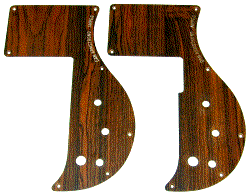
|
These instruments were trimmed with scratchplates made of high-pressure laminate (HPL) with a melamine surface printed to look like wood grain
with matching wood grain headstocks. According to Matt Umanov the prototype was trimmed with rosewood until Dan started using Formica.
When asked Matt replied "Best I can recall, Danny went out and bought some Formica, I suppose they found something
similar, if not identical, for production." On the earliest models, the wiring harness was attached to the underside of the formica pickguard
with tape.
|
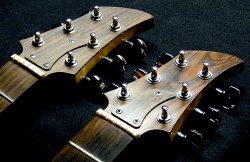
|
Earlier models (right) have Formica that's smooth to the touch, while later models (left) have a texture to it.
Dan told me that "Our supplier, Rohm & Haas, switched over and began to produce a more textured look to the wood
grained Formica veneer." It is unknown for certain when the change occured, but based on serial numbers, the best
guess is that it happened near, or in early 1970, thus making the 1969 models the only instruments to feature the
smooth, glossy type Formica.
|
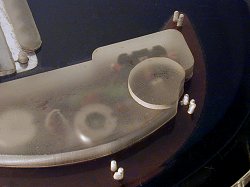
|
There is, however, a marked difference in the placement of the mounting holes between a smooth, glossy surface
scratchplate and a textured scratchplate. The textured scratchplates were wider by a small margin. As a result, and
as can be seen at left, installing a textured type scratchplate onto an older guitar body that originally had a smooth,
glossy scratchplate quickly reveals that the mounting holes on the guitar body do not line up.
|
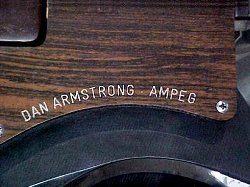
|
As seen at left, the acrylic bodies are drilled and tapped to accept the mounting screws used to secure the scratchplate to the acrylic body.
These screws are phillips headed and chrome plated. The taper headed screws fit virtually flush with the scratchplate when turned fully in and match
up nicely with the chrome plated scratchplate surroundings. These same screws were used to mount the truss rod cover to the headstock. The wood grained
Formica scratchplate is adorned with the words Dan Armstrong · Ampeg etched into it with white lettering.
|
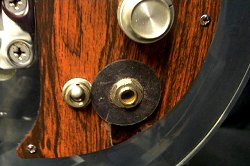
|
Over the years players have sometimes had problems as they sometimes tend to step on their patch cord which in turn
pulled on the plug that went into the jack on the scratchplate. Since the force being applied was more downward
and not outward, the jack did not unplug, instead it cracked the scratchplate in and around the jack.
In todays world of wireless connections patch cords are almost non-existent but time was when using a patch cord was
the only way. Many players felt that the scratchplate material on the Dan Armstrong instruments were just too brittle
as a result.
|
In all fairness, it's worth mentioning that many Les Paul jack plates are broken each year as well, and usually
replaced with metal ones. In the past, and as can be seen above left, guitar players would often times install a large
washer under the output jack's nut to solve this problem, though for better structure, not to mention cosmetics, it is suggested to put
the washer on the underside of the Formica. Alternatively, one can always get a replacement pickguard from places like
Pickguard Heaven.
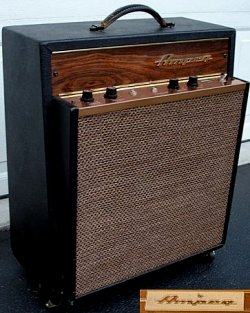
|
Although there is no evidence to suggest any connection it is nevertheless interesting, to me anyway, to note that certain Ampeg amplifiers
like this 1968 'Reverbojet' model had their own type of faux wood trimmings on them.
These amps were being produced at the very same time Dan was
designing the acrylic guitars & basses. Did Dan see these amps & decide to use something similar on his instruments? It would seem unlikely, and
it's probably just a coincidence, but I can't help but wonder.
|
continue
menu
Names and images are TMand © Dan Armstrong / Ampeg. All rights reserved.
All other names and images are TMand © of their respective owners. All rights reserved.
|
| |

